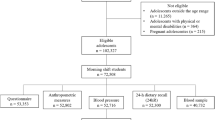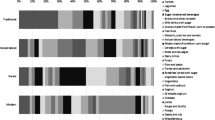Abstract
Objective:
To describe the pattern of meal glycaemic load of children in Hong Kong and to determine whether the meal glycaemic load is associated with childhood overweight.
Method:
Dietary records (3-day) of 316 Hong Kong children aged 6–7 years were collected. Glycaemic load was calculated from the estimated weight (WT), carbohydrate content (%CHO) and glycaemic index (GI) of each food taken using the equation: (% CHO × GI × WT/100). The meal glycaemic load was then the sum of the glycaemic loads of all food taken in each meal. Logistic regression analyses were used to compare the average meal glycaemic load (of breakfast, lunch and dinner) and other dietary parameters between overweight children and normal-weight children.
Results:
Breakfast, lunch, dinner and snacks provided, respectively, 17, 29, 29 and 25% of the total glycaemic load in a day. White rice (excluding congee (rice porridge) and glutinous rice) contributed almost half of the total glycaemic load. Adjusted logistic regression showed that the meal glycaemic load was not significantly associated with childhood overweight after adjusting for parental obesity, birth weight, sleeping duration, mean energy intake and paternal smoking.
Conclusion:
Meal glycaemic load calculated from current diet was not an independent factor associated with childhood overweight in children aged 6–7 years. Our data suggested that modifying the type of rice/staple consumed and choosing low-GI snacks could have a major influence on the total meal glycaemic load of young Hong Kong children.
This is a preview of subscription content, access via your institution
Access options
Subscribe to this journal
Receive 12 print issues and online access
$259.00 per year
only $21.58 per issue
Buy this article
- Purchase on Springer Link
- Instant access to full article PDF
Prices may be subject to local taxes which are calculated during checkout


Similar content being viewed by others
References
Alvina M, Araya H (2004). Rapid carbohydrate digestion rate produced lesser short-term satiety in obese preschool children. Eur J Clin Nutr 58, 637–642.
Anderson GH, Catherine NL, Woodend DM, Wolever TM (2002). Inverse association between the effect of carbohydrates on blood glucose and subsequent short-term food intake in young men. Am J Clin Nutr 76, 1023–1030.
Astrup A, Ryan L, Grunwald GK, Storgaard M, Saris W, Melanson E et al. (2000). The role of dietary fat in body fatness: evidence from a preliminary meta-analysis of ad libitum low-fat dietary intervention studies. Br J Nutr 83 (Suppl 1), S25–S32.
Augustin LS, Dal Maso L, La Vecchia C, Parpinel M, Negri E, Vaccarella S et al. (2001). Dietary glycemic index and glycemic load, and breast cancer risk: a case–control study. Ann Oncol 12, 1533–1538.
Ball SD, Keller KR, Moyer-Mileur LJ, Ding YW, Donaldson D, Jackson WD (2003). Prolongation of satiety after low versus moderately high glycemic index meals in obese adolescents. Pediatrics 111, 488–493.
Bessesen DH (2001). The role of carbohydrates in insulin resistance. J Nutr 131, 2782S–2786S.
Bjorck I, Liljeberg H, Ostman E (2000). Low glycaemic-index foods. Br J Nutr 83 (Suppl 1), S149–S155.
Brand MJ, Foster-Powell K (1998). The Glucose Revolution Pocket Guide to the Top 100 Low Glycemic Foods. Marlowe & Company: New York, NY.
Brand MJ, Foster-Powell K, Colagiuri S, Leeds A (1996). The GI Factor: The Glucose Revolution. Griffin Press Pty Ltd: Netley, South Australia.
Brand-Miller JC, Thomas M, Swan V, Ahmad ZI, Petocz P, Colagiuri S (2003). Physiological validation of the concept of glycemic load in lean young adults. J Nutr 133, 2728–2732.
Buyken AE, Toeller M, Heitkamp G, Karamanos B, Rottiers R, Muggeo M, et al., EURODIAB IDDM Complications Study Group (2001). Glycemic index in the diet of European outpatients with type 1 diabetes: relations to glycated hemoglobin and serum lipids. Am J Clin Nutr 73, 574–581.
Cole TJ, Bellizzi MC, Flegal KM, Dietz WH (2000). Establishing a standard definition for child overweight and obesity worldwide: international survey. BMJ 320, 1240–1243.
Ebbeling CBL (2001). Treating obesity in youth: should dietary glycemic load be a consideration? Adv Pediatr 48, 179–212.
FAO/WHO (1998). Carbohydrates in human nutrition. Report of a Joint FAO/WHO Expert Consultation. FAO Food Nutr Paper 66, 1–140.
Flint A, Moller BK, Raben A, Pedersen D, Tetens I, Holst JJ et al. (2004). The use of glycaemic index tables to predict glycaemic index of composite breakfast meals. Br J Nutr 91, 979–989.
Foster-Powell K, Holt SH, Brand-Miller JC (2002). International table of glycemic index and glycemic load values: 2002. Am J Clin Nutr 76, 5–56.
Foster-Powell K, Miller JB (1995). International tables of glycemic index. Am J Clin Nutr 62, 871S–890S.
Franceschi S, Dal Maso L, Augustin L, Negri E, Parpinel M, Boyle P et al. (2001). Dietary glycemic load and colorectal cancer risk. Ann Oncol 12, 173–178.
Frost G, Leeds AA, Dore CJ, Madeiros S, Brading S, Dornhorst A (1999). Glycaemic index as a determinant of serum HDL-cholesterol concentration. Lancet 353, 1045–1048.
Gilbertson HR, Brand-Miller JC, Thorburn AW, Evans S, Chondros P, Werther GA (2001). The effect of flexible low glycemic index dietary advice versus measured carbohydrate exchange diets on glycemic control in children with type 1 diabetes. Diabetes Care 24, 1137–1143.
Heini AF, Kirk KA, Lara-Castro C, Weinsier RL (1998). Relationship between hunger-satiety feelings and various metabolic parameters in women with obesity during controlled weight loss. Obes Res 6, 225–230.
Heitmann BL, Lissner L, Sorensen TI, Bengtsson C (1995). Dietary fat intake and weight gain in women genetically predisposed for obesity. Am J Clin Nutr 61, 1213–1217.
Holt S, Brand J, Soveny C, Hansky J (1992). Relationship of satiety to postprandial glycaemic, insulin and cholecystokinin responses. Appetite 18, 129–141.
Hui LL, Nelson EA, Yu LM, Li AM, Fok TF (2003). Risk factors for childhood overweight in 6- to 7-y-old Hong Kong children. Int J Obes Relat Metab Disord 27, 1411–1418.
Jenkins DJ, Wolever TM, Collier GR, Ocana A, Rao AV, Buckley G et al. (1987). Metabolic effects of a low-glycemic-index diet. Am J Clin Nutr 46, 968–975.
Jimenez-Cruz A, Bacardi-Gascon M, Turnbull WH, Rosales-Garay P, Severino-Lugo I (2003). A flexible, low-glycemic index Mexican-style diet in overweight and obese subjects with type 2 diabetes improves metabolic parameters during a 6-week treatment period. Diabetes Care 26, 1967–1970.
Leung SS, Chan SM, Lui S, Lee WTK, Davies DP (1999). Growth and nutrition of Hong Kong children aged 0–7 years. J Paediatr Child Health 36, 56–65.
Leung SS, Lau JT, Tse LY, Oppenheimer SJ (1996). Weight-for-age and weight-for-height references for Hong Kong children from birth to 18 years. J Paediatr Child Health 32, 103–109.
Liu S, Manson JE, Stampfer MJ, Holmes MD, Hu FB, Hankinson SE et al. (2001). Dietary glycemic load assessed by food-frequency questionnaire in relation to plasma high-density-lipoprotein cholesterol and fasting plasma triacylglycerols in postmenopausal women. Am J Clin Nutr 73, 560–566.
Liu S, Willett WC, Stampfer MJ, Hu FB, Franz M, Sampson L et al. (2000). A prospective study of dietary glycemic load, carbohydrate intake, and risk of coronary heart disease in US women. Am J Clin Nutr 71, 1455–1461.
Ludwig DS (2000). Dietary glycemic index and obesity. J Nutr 130, 280S–283S.
Ludwig DS (2002). The glycemic index: physiological mechanisms relating to obesity, diabetes, and cardiovascular disease. JAMA 287, 2414–2423.
Ludwig DS, Majzoub JA, Al Zahrani A, Dallal GE, Blanco I, Roberts SB (1999). High glycemic index foods, overeating, and obesity. Pediatrics 103, E26.
Milner JA, Allison RG (1999). The role of dietary fat in child nutrition and development: summary of an ASNS workshop. American Society for Nutritional Sciences. J Nutr 129, 2094–2105.
Monro JA, Williams M (2000). Concurrent management of postprandial glycaemia and nutrient intake using glycemic glucose equivalents, food composition data and computer-assisted meal design. Asia Pac J Clin Nutr 9, 67–73.
Montignac M (1999). Eat yourself Slim… and Stay Slim. Nutrimont/Montignac Publishing UK Ltd: UK.
Muecke L, Simons-Morton B, Huang IW, Parcel G (1992). Is childhood obesity associated with high-fat foods and low physical activity? J School Health 62, 19–23.
Pawlak DB, Ebbeling CB, Ludwig DS (2002). Should obese patients be counselled to follow a low-glycaemic index diet? Yes Obes Rev 3, 235–243.
Perusse L, Bouchard C (2000). Gene–diet interactions in obesity. Am J Clin Nutr 72, 1285S–1290S.
Pi-Sunyer FX (2002). Glycemic index and disease. Am J Clin Nutr 76, 290S–298S.
Raben A (2002). Should obese patients be counselled to follow a low-glycaemic index diet? No. Obes Rev 3, 245–256.
Slabber M, Barnard HC, Kuyl JM, Dannhauser A, Schall R (1994). Effects of a low-insulin-response, energy-restricted diet on weight loss and plasma insulin concentrations in hyperinsulinemic obese females. Am J Clin Nutr 60, 48–53.
Sloth B, Krog-Mikkelsen I, Flint A, Tetens I, Bjorck I, Vinoy S et al. (2004). No difference in body weight decrease between a low-glycemic-index and a high-glycemic-index diet but reduced LDL cholesterol after 10-wk ad libitum intake of the low-glycemic-index diet. Am J Clin Nutr 80, 337–347.
Spieth LE, Harnish JD, Lenders CM, Raezer LB, Pereira MA, Hangen SJ et al. (2000). A low-glycemic index diet in the treatment of pediatric obesity. Arch Pediatr Adolesc Med 154, 947–951.
Sydney University GI Research Service (SUGiRS) (2002). The Human Nutrition Unit, Department of Biochemistry, The University of Sydney,http://www.glycemicindex.com/.
Troiano RP, Briefel RR, Carroll MD, Bialostosky K (2000). Energy and fat intakes of children and adolescents in the United States: data from the national health and nutrition examination surveys. Am J Clin Nutr 72, 1343S–1353S.
Warren JM, Henry CJ, Simonite V (2003). Low glycemic index breakfasts and reduced food intake in preadolescent children. Pediatrics 112, e414–e419.
WHO (2000). Obesity: preventing and managing the global epidemic: report of a WHO Consultation. World Health Organization: Geneva. Technical Report Series 894, p 101.
Wolever TMS, Bolognesi C (1996). Prediction of glucose and insulin responses of normal subjects after consuming mixed meals varying in energy, protein, fat, carbohydrate and glycemic index. J Nutr 126, 2807–2812.
Wolever TMS, Jenkins DJ, Jenkins AL, Josse RG (1991). The glycemic index: methodology and clinical implications. Am J Clin Nutr 54, 846–854.
Wolever TMS, Mehling C (2003). Long-term effect of varying the source or amount of dietary carbohydrate on postprandial plasma glucose, insulin, triacylglycerol, and free fatty acid concentrations in subjects with impaired glucose tolerance. Am J Clin Nutr 77, 612–621.
Acknowledgements
We thank Professor J Brand Miller and Dr S Holt of the Human Nutrition Unit, University of Sydney for their advice on GI values of foods, and Ms LM Yu (Centre for Clinical Trial and Epidemiological Research, Chinese University of Hong Kong) for her statistical advice. We are also grateful to Dr LY Tse, Dr G Tong and the doctors and nurses in the Student Health Service Centres, Department of Health, for helping to recruit the subjects for this study.
Author information
Authors and Affiliations
Corresponding author
Rights and permissions
About this article
Cite this article
Hui, L., Nelson, E. Meal glycaemic load of normal-weight and overweight Hong Kong children. Eur J Clin Nutr 60, 220–227 (2006). https://doi.org/10.1038/sj.ejcn.1602305
Received:
Revised:
Accepted:
Published:
Issue Date:
DOI: https://doi.org/10.1038/sj.ejcn.1602305
Keywords
This article is cited by
-
Breakfast and dinner insulin index and insulin load in relation to overweight in children and adolescents
European Journal of Nutrition (2021)
-
A randomized controlled trial to investigate the impact of a low glycemic index (GI) diet on body mass index in obese adolescents
BMC Public Health (2014)
-
Dietary glycemic index and glycemic load in relation to risk of overweight in Japanese children and adolescents: the Ryukyus Child Health Study
International Journal of Obesity (2011)



